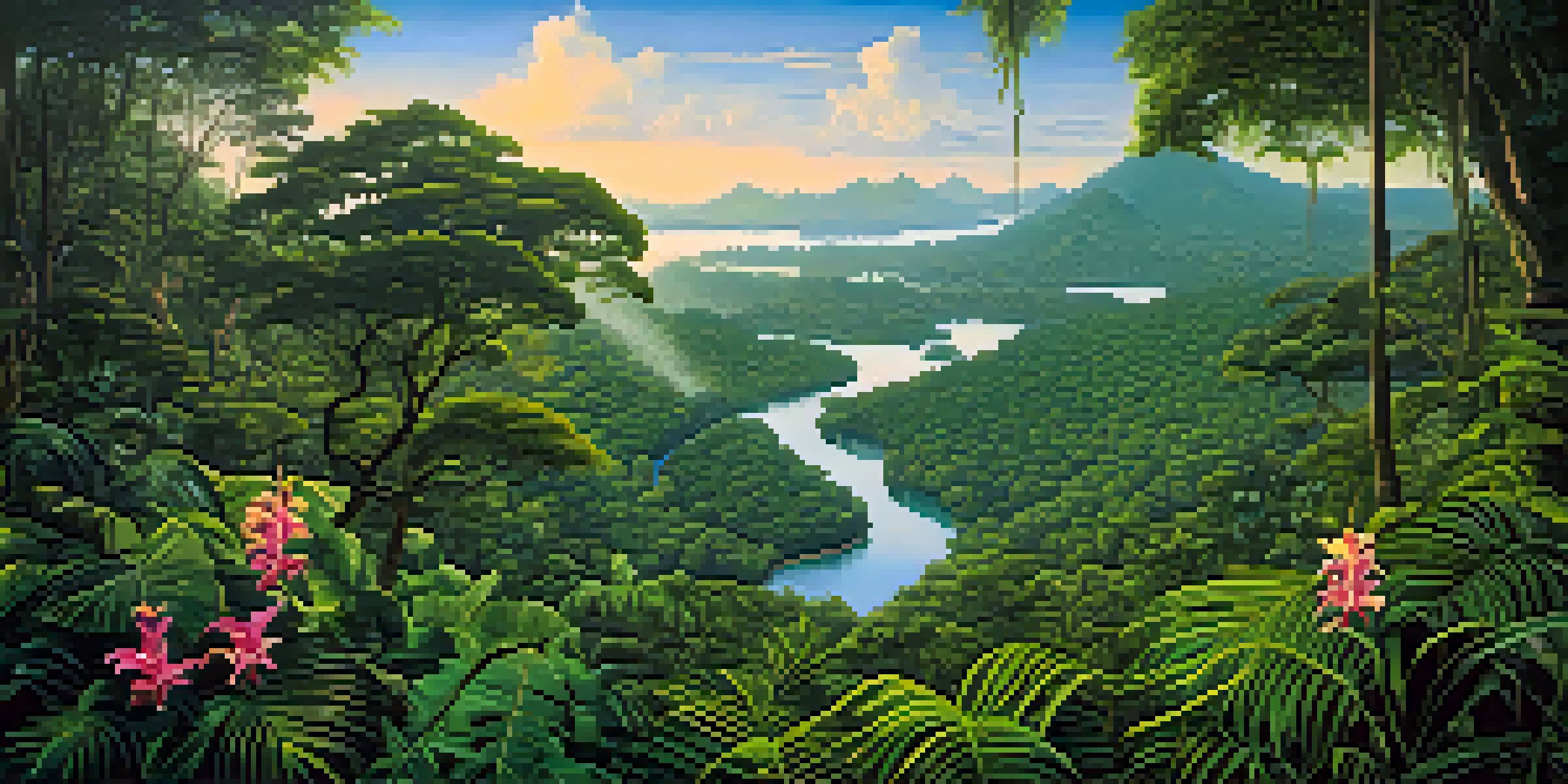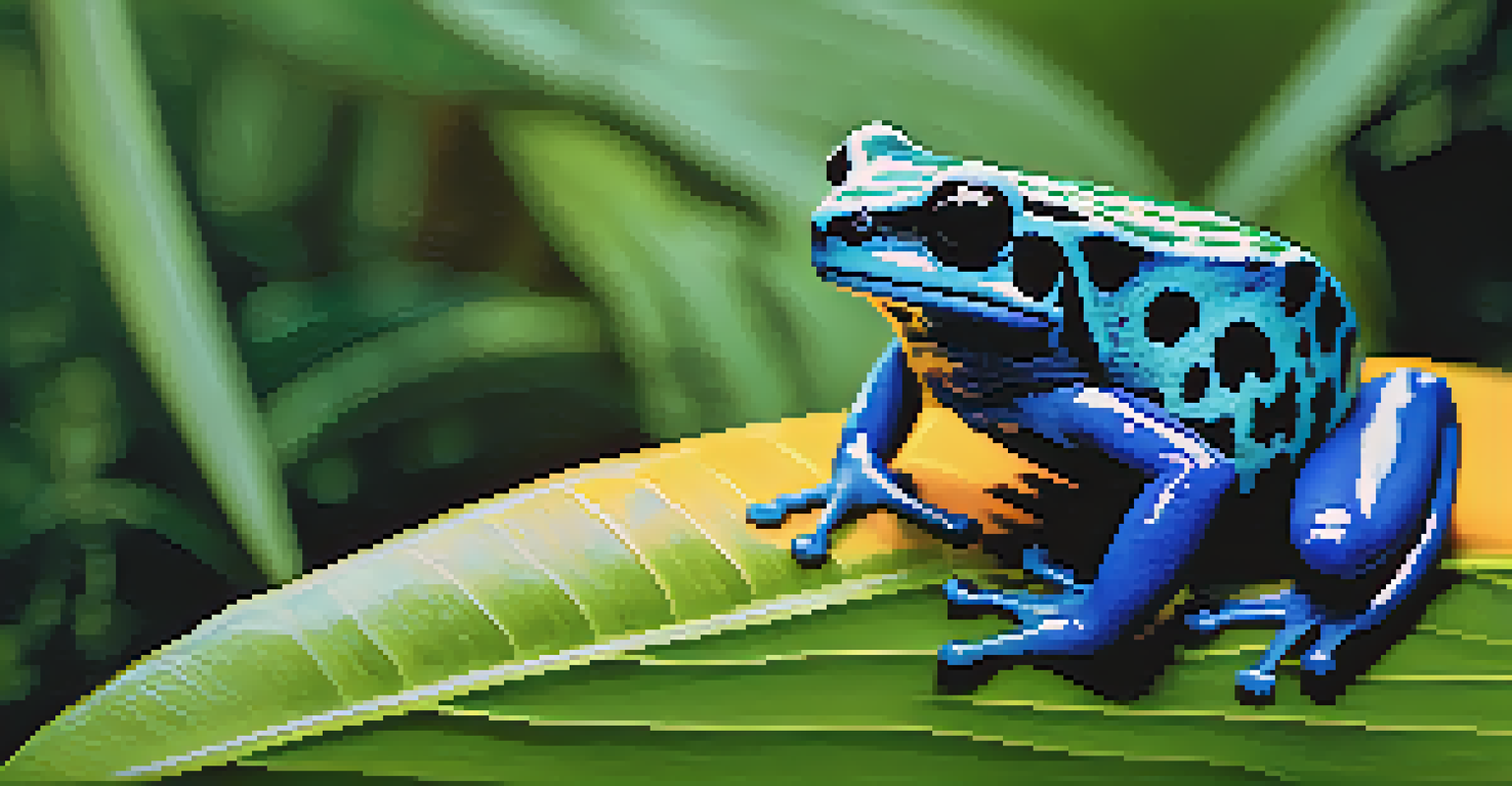The Amazon Rainforest: Brazil's Wildlife Treasure Trove

The Amazon Rainforest: A Global Biodiversity Hub
The Amazon Rainforest is often referred to as the lungs of the Earth, and for good reason. Covering over 5.5 million square kilometers, it houses an astonishing variety of flora and fauna. This vast biodiversity makes it one of the most important ecosystems on the planet, playing a crucial role in carbon storage and oxygen production.
The Amazon is the world's largest rainforest and it is essential for the health of our planet.
Home to approximately 390 billion individual trees, the Amazon is a treasure trove of species, many of which are not found anywhere else in the world. From towering kapok trees to the vibrant orchids that adorn the forest floor, the plant life here is nothing short of mesmerizing. Each plant contributes to the complex web of life, supporting countless animal species.
Moreover, the Amazon is a critical habitat for an array of wildlife, including jaguars, sloths, and countless bird species. This rich diversity is not just fascinating; it’s essential for maintaining ecological balance and supporting local communities that rely on these resources for their livelihoods.
Unique Species of the Amazon: The Stars of the Show
The Amazon is home to some of the most unique and intriguing species on the planet. For instance, the Amazonian river dolphin, or boto, is a pink-hued marvel that captivates those lucky enough to spot it. Known for their intelligence and playful behavior, these dolphins are a symbol of the rainforest’s enchanting wildlife.

Another remarkable resident is the poison dart frog, famed for its vibrant colors. While stunning to look at, these little amphibians carry potent toxins that indigenous tribes have used for centuries in their hunting practices. This duality of beauty and danger is just one example of the complexities found within the Amazon's ecosystem.
Amazon's Biodiversity is Crucial
The Amazon Rainforest is home to an incredible variety of species, making it essential for ecological balance and local livelihoods.
Then there's the majestic jaguar, the largest cat in the Americas, which prowls the forest floor with grace and power. Jaguars play a vital role in controlling the populations of other species, thus maintaining a healthy ecosystem. These unique creatures are not just part of the wildlife; they are integral to the forest's health and sustainability.
The Importance of Conservation in the Amazon
With such rich biodiversity, it’s no surprise that the Amazon Rainforest is under constant threat from deforestation and climate change. These activities not only endanger wildlife but also disrupt the delicate balance of the ecosystem. Conservation efforts are crucial to preserving this irreplaceable treasure trove of life.
We won't have a society if we destroy the environment.
Initiatives such as reforestation projects and wildlife reserves are essential in protecting the Amazon's diverse species. Organizations are working tirelessly to educate local communities about sustainable practices that benefit both the environment and their livelihoods. By fostering a deeper understanding of the rainforest's importance, people can contribute to its preservation.
Furthermore, international cooperation is vital in addressing the challenges faced by the Amazon. Countries, NGOs, and global citizens must unite to combat the threats that jeopardize this vital ecosystem. Together, we can ensure that future generations enjoy the wonders of the Amazon Rainforest just as we do today.
Indigenous Peoples: Guardians of the Amazon
The Amazon is not just a habitat for wildlife; it is also home to numerous indigenous peoples who have lived in harmony with the forest for centuries. These communities possess invaluable knowledge about the ecosystem, often understanding its intricacies better than anyone else. Their deep-rooted connection to the land makes them essential guardians of the rainforest.
Indigenous practices often focus on sustainable living, utilizing resources without depleting them. For instance, they have traditional methods of agriculture that promote biodiversity and soil health. By observing these practices, modern conservationists can learn important lessons on sustainability and environmental stewardship.
Conservation Efforts Are Vital
To combat threats like deforestation and climate change, conservation initiatives and international cooperation are necessary to preserve the Amazon.
However, these communities face significant challenges from external pressures such as logging and mining. Advocacy for indigenous rights and their involvement in conservation efforts is critical to protecting both their culture and the Amazon itself. Empowering these communities not only enriches conservation efforts but also honors their invaluable role in preserving the rainforest.
The Amazon's Role in Climate Regulation
The Amazon Rainforest plays a vital role in regulating the Earth's climate. It absorbs vast amounts of carbon dioxide, helping to mitigate climate change effects. This natural process is essential for maintaining global temperature levels and supporting life on Earth.
Moreover, the rainforest influences local and global weather patterns. The trees release water vapor through a process called transpiration, which contributes to cloud formation and precipitation. This not only sustains the rainforest itself but also affects agricultural productivity in distant regions.
As climate change accelerates, protecting the Amazon becomes increasingly critical. Preserving this ecosystem is not just about saving wildlife; it's about safeguarding our planet's climate stability. Every effort to conserve the rainforest is a step toward a healthier future for all of us.
Tourism: A Double-Edged Sword for the Amazon
Tourism in the Amazon can be a double-edged sword. On one hand, ecotourism offers a sustainable way to generate income for local communities while promoting conservation. Visitors can experience the breathtaking beauty of the rainforest and its wildlife, fostering a greater appreciation for its preservation.
On the other hand, unchecked tourism can lead to environmental degradation. Issues such as littering, habitat disturbance, and the introduction of invasive species can threaten the delicate ecosystem. It’s crucial for tourism to be managed responsibly to ensure that it benefits both the environment and the local people.
Indigenous Peoples as Guardians
Indigenous communities possess invaluable knowledge about the Amazon ecosystem, making their involvement critical in conservation efforts.
Sustainable tourism initiatives are emerging, focusing on minimizing impact while maximizing benefits. By choosing eco-friendly travel options and supporting local businesses, visitors can play a role in protecting the Amazon. Ultimately, responsible tourism can help create a balance between enjoyment and conservation.
Future of the Amazon: Challenges and Hope
The future of the Amazon Rainforest hangs in the balance, with significant challenges ahead. Deforestation, climate change, and industrial development threaten its rich biodiversity and the indigenous cultures that depend on it. However, there is hope in the form of global awareness and efforts to address these issues.
Grassroots movements and international partnerships are gaining momentum, advocating for stronger protections for the Amazon. Awareness campaigns are educating the public about the importance of the rainforest, inspiring individuals to take action. Every small step counts, from supporting sustainable products to voicing concerns to policymakers.

Ultimately, the preservation of the Amazon requires a collective effort. With continued advocacy, education, and a commitment to sustainability, we can protect this treasure trove of wildlife for generations to come. The Amazon's story is still being written, and we all have a part to play.